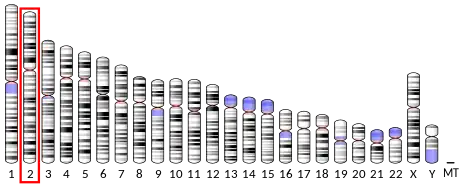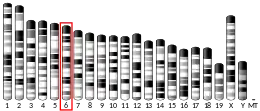REG1B
Lithostathine-1-beta is a protein that in humans is encoded by the REG1B gene.[5][6]
| REG1B | |||||||||||||||||||||||||||||||||||||||||||||||||||
|---|---|---|---|---|---|---|---|---|---|---|---|---|---|---|---|---|---|---|---|---|---|---|---|---|---|---|---|---|---|---|---|---|---|---|---|---|---|---|---|---|---|---|---|---|---|---|---|---|---|---|---|
| Identifiers | |||||||||||||||||||||||||||||||||||||||||||||||||||
| Aliases | REG1B, PSPS2, REGH, REGI-BETA, REGL, regenerating family member 1 beta | ||||||||||||||||||||||||||||||||||||||||||||||||||
| External IDs | OMIM: 167771 MGI: 97896 HomoloGene: 68517 GeneCards: REG1B | ||||||||||||||||||||||||||||||||||||||||||||||||||
| |||||||||||||||||||||||||||||||||||||||||||||||||||
| |||||||||||||||||||||||||||||||||||||||||||||||||||
| |||||||||||||||||||||||||||||||||||||||||||||||||||
| |||||||||||||||||||||||||||||||||||||||||||||||||||
| |||||||||||||||||||||||||||||||||||||||||||||||||||
| Wikidata | |||||||||||||||||||||||||||||||||||||||||||||||||||
| |||||||||||||||||||||||||||||||||||||||||||||||||||
Function
This gene is a type I subclass member of the Reg gene family. The Reg gene family is a multigene family grouped into four subclasses, types I, II, III and IV based on the primary structures of the encoded proteins. This gene encodes a protein that is secreted by the exocrine pancreas. It is associated with islet cell regeneration and diabetogenesis and may be involved in pancreatic lithogenesis. Reg family members REG1A, REGL, PAP and this gene are tandemly clustered on chromosome 2p12 and may have arisen from the same ancestral gene by gene duplication.[6]
References
- GRCh38: Ensembl release 89: ENSG00000172023 - Ensembl, May 2017
- GRCm38: Ensembl release 89: ENSMUSG00000023140 - Ensembl, May 2017
- "Human PubMed Reference:". National Center for Biotechnology Information, U.S. National Library of Medicine.
- "Mouse PubMed Reference:". National Center for Biotechnology Information, U.S. National Library of Medicine.
- Moriizumi S, Watanabe T, Unno M, Nakagawara K, Suzuki Y, Miyashita H, Yonekura H, Okamoto H (Mar 1994). "Isolation, structural determination and expression of a novel reg gene, human regI beta". Biochim Biophys Acta. 1217 (2): 199–202. doi:10.1016/0167-4781(94)90035-3. PMID 8110835.
- "Entrez Gene: REG1B regenerating islet-derived 1 beta (pancreatic stone protein, pancreatic thread protein)".
Further reading
- De Reggi M, Gharib B (2002). "Protein-X, Pancreatic Stone-, Pancreatic thread-, reg-protein, P19, lithostathine, and now what? Characterization, structural analysis and putative function(s) of the major non-enzymatic protein of pancreatic secretions". Curr. Protein Pept. Sci. 2 (1): 19–42. doi:10.2174/1389203013381233. PMID 12369899.
- Itoh T, Tsuzuki H, Katoh T, Teraoka H, Matsumoto K, Yoshida N, Terazono K, Watanabe T, Yonekura H, Yamamoto H (1990). "Isolation and characterization of human reg protein produced in Saccharomyces cerevisiae". FEBS Lett. 272 (1–2): 85–8. doi:10.1016/0014-5793(90)80454-Q. PMID 2226837. S2CID 31078322.
- Watanabe T, Yonekura H, Terazono K, Yamamoto H, Okamoto H (1990). "Complete nucleotide sequence of human reg gene and its expression in normal and tumoral tissues. The reg protein, pancreatic stone protein, and pancreatic thread protein are one and the same product of the gene". J. Biol. Chem. 265 (13): 7432–9. doi:10.1016/S0021-9258(19)39132-X. PMID 2332435.
- de la Monte SM, Ozturk M, Wands JR (1990). "Enhanced expression of an exocrine pancreatic protein in Alzheimer's disease and the developing human brain". J. Clin. Invest. 86 (3): 1004–13. doi:10.1172/JCI114762. PMC 296822. PMID 2394826.
- De Caro AM, Adrich Z, Fournet B, Capon C, Bonicel JJ, De Caro JD, Rovery M (1989). "N-terminal sequence extension in the glycosylated forms of human pancreatic stone protein. The 5-oxoproline N-terminal chain is O-glycosylated on the 5th amino acid residue". Biochim. Biophys. Acta. 994 (3): 281–4. doi:10.1016/0167-4838(89)90305-1. PMID 2493268.
- Giorgi D, Bernard JP, Rouquier S, Iovanna J, Sarles H, Dagorn JC (1989). "Secretory pancreatic stone protein messenger RNA. Nucleotide sequence and expression in chronic calcifying pancreatitis". J. Clin. Invest. 84 (1): 100–6. doi:10.1172/JCI114128. PMC 303958. PMID 2525567.
- Stewart TA (1989). "The human reg gene encodes pancreatic stone protein". Biochem. J. 260 (2): 622–3. doi:10.1042/bj2600622. PMC 1138718. PMID 2764894.
- Terazono K, Yamamoto H, Takasawa S, Shiga K, Yonemura Y, Tochino Y, Okamoto H (1988). "A novel gene activated in regenerating islets". J. Biol. Chem. 263 (5): 2111–4. doi:10.1016/S0021-9258(18)69176-8. PMID 2963000.
- Rouimi P, Bonicel J, Rovery M, De Caro A (1987). "Cleavage of the Arg-Ile bond in the native polypeptide chain of human pancreatic stone protein". FEBS Lett. 216 (2): 195–9. doi:10.1016/0014-5793(87)80688-9. PMID 3108036. S2CID 37809879.
- Montalto G, Bonicel J, Multigner L, Rovery M, Sarles H, De Caro A (1987). "Partial amino acid sequence of human pancreatic stone protein, a novel pancreatic secretory protein". Biochem. J. 238 (1): 227–32. doi:10.1042/bj2380227. PMC 1147119. PMID 3541906.
- De Caro AM, Bonicel JJ, Rouimi P, De Caro JD, Sarles H, Rovery M (1987). "Complete amino acid sequence of an immunoreactive form of human pancreatic stone protein isolated from pancreatic juice". Eur. J. Biochem. 168 (1): 201–7. doi:10.1111/j.1432-1033.1987.tb13405.x. PMID 3665916.
- Gross J, Carlson RI, Brauer AW, Margolies MN, Warshaw AL, Wands JR (1986). "Isolation, characterization, and distribution of an unusual pancreatic human secretory protein". J. Clin. Invest. 76 (6): 2115–26. doi:10.1172/JCI112216. PMC 424321. PMID 3908481.
- De Reggi M, Capon C, Gharib B, Wieruszeski JM, Michel R, Fournet B (1995). "The glycan moiety of human pancreatic lithostathine. Structure characterization and possible pathophysiological implications". Eur. J. Biochem. 230 (2): 503–10. doi:10.1111/j.1432-1033.1995.tb20589.x. PMID 7607222.
- Gharib B, Fox MF, Bartoli C, Giorgi D, Sansonetti A, Swallow DM, Dagorn JC, Berge-lefranc JL (1993). "Human regeneration protein/lithostathine genes map to chromosome 2p12". Ann. Hum. Genet. 57 (Pt 1): 9–16. doi:10.1111/j.1469-1809.1993.tb00882.x. PMID 8333731. S2CID 19794817.
- Bartoli C, Gharib B, Giorgi D, Sansonetti A, Dagorn JC, Bergé-Lefranc JL (1993). "A gene homologous to the reg gene is expressed in the human pancreas". FEBS Lett. 327 (3): 289–93. doi:10.1016/0014-5793(93)81006-L. PMID 8348956. S2CID 44565895.
- Miyashita H, Nakagawara K, Mori M, Narushima Y, Noguchi N, Moriizumi S, Takasawa S, Yonekura H, Takeuchi T, Okamoto H (1996). "Human REG family genes are tandemly ordered in a 95-kilobase region of chromosome 2p12". FEBS Lett. 377 (3): 429–33. doi:10.1016/0014-5793(95)01381-4. PMID 8549770. S2CID 5872129.
- Bertrand JA, Pignol D, Bernard JP, Verdier JM, Dagorn JC, Fontecilla-Camps JC (1996). "Crystal structure of human lithostathine, the pancreatic inhibitor of stone formation". EMBO J. 15 (11): 2678–84. doi:10.1002/j.1460-2075.1996.tb00628.x. PMC 450203. PMID 8654365.
- Patard L, Stoven V, Gharib B, Bontems F, Lallemand JY, De Reggi M (1997). "What function for human lithostathine?: structural investigations by three-dimensional structure modeling and high-resolution NMR spectroscopy". Protein Eng. 9 (11): 949–57. doi:10.1093/protein/9.11.949. PMID 8961348.
- Bartoli C, Baeza N, Figarella C, Pellegrini I, Figarella-Branger D (1998). "Expression of peptide-23/pancreatitis-associated protein and Reg genes in human pituitary and adenomas: comparison with other fetal and adult human tissues". J. Clin. Endocrinol. Metab. 83 (11): 4041–6. doi:10.1210/jcem.83.11.5217. PMID 9814489.
This article is issued from Wikipedia. The text is licensed under Creative Commons - Attribution - Sharealike. Additional terms may apply for the media files.




